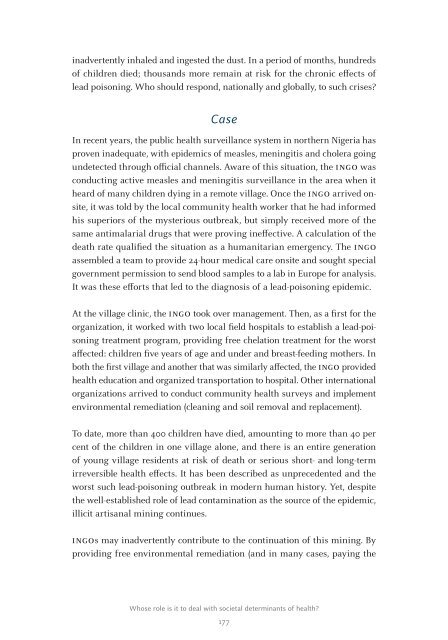PoPulationand Public HealtH etHics
PoPulationand Public HealtH etHics
PoPulationand Public HealtH etHics
You also want an ePaper? Increase the reach of your titles
YUMPU automatically turns print PDFs into web optimized ePapers that Google loves.
inadvertently inhaled and ingested the dust. In a period of months, hundreds<br />
of children died; thousands more remain at risk for the chronic effects of<br />
lead poisoning. Who should respond, nationally and globally, to such crises?<br />
Case<br />
In recent years, the public health surveillance system in northern Nigeria has<br />
proven inadequate, with epidemics of measles, meningitis and cholera going<br />
undetected through official channels. Aware of this situation, the Ingo was<br />
conducting active measles and meningitis surveillance in the area when it<br />
heard of many children dying in a remote village. Once the Ingo arrived onsite,<br />
it was told by the local community health worker that he had informed<br />
his superiors of the mysterious outbreak, but simply received more of the<br />
same antimalarial drugs that were proving ineffective. A calculation of the<br />
death rate qualified the situation as a humanitarian emergency. The Ingo<br />
assembled a team to provide 24-hour medical care onsite and sought special<br />
government permission to send blood samples to a lab in Europe for analysis.<br />
It was these efforts that led to the diagnosis of a lead-poisoning epidemic.<br />
At the village clinic, the Ingo took over management. Then, as a first for the<br />
organization, it worked with two local field hospitals to establish a lead-poisoning<br />
treatment program, providing free chelation treatment for the worst<br />
affected: children five years of age and under and breast-feeding mothers. In<br />
both the first village and another that was similarly affected, the Ingo provided<br />
health education and organized transportation to hospital. Other international<br />
organizations arrived to conduct community health surveys and implement<br />
environmental remediation (cleaning and soil removal and replacement).<br />
To date, more than 400 children have died, amounting to more than 40 per<br />
cent of the children in one village alone, and there is an entire generation<br />
of young village residents at risk of death or serious short- and long-term<br />
irreversible health effects. It has been described as unprecedented and the<br />
worst such lead-poisoning outbreak in modern human history. Yet, despite<br />
the well-established role of lead contamination as the source of the epidemic,<br />
illicit artisanal mining continues.<br />
Ingos may inadvertently contribute to the continuation of this mining. By<br />
providing free environmental remediation (and in many cases, paying the<br />
Whose role is it to deal with societal determinants of health?<br />
177
















